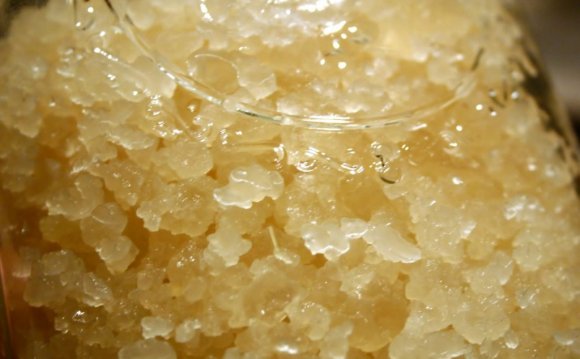

Q. I just received my milk kefir grains and they don't appear to be working.
A. Milk kefir grains generally take 3-7 days to activate and properly culture milk kefir. Culture according to the instructions. If you have questions or concerns, be sure to contact Customer Support.
Q. My milk kefir seems to have separated into curds and whey. Why did this happen?
A. Kefir will separate if it over-cultures. To prevent this from happening:
- Increase the amount of milk
- Reduce the amount of grains
- Reduce the amount of time you culture the milk kefir
Q. I've been making milk kefir for awhile but the taste of my kefir seems to have changed. Why?
A. The taste and texture of kefir depends on several factors. The culture time, the temperature of your home, and the ratio of kefir grains to milk.
If the temperature of your home has changed, you may need to adjust the culturing time. If your kefir grains have multiplied, you may choose to either remove a portion of the kefir grains or increase the amount of milk. Extra grains can be used to start a second batch of kefir, given to a friend, or dried and stored as backup.
Q. Some of the milk kefir sticks to my kefir grains. Is that okay?
A. It is normal for kefir to cling to the grains and it does not present a problem. Strain the grains as best as you can and don't worry about smaller layers that remain on the kefir grains.
Q. My milk kefir smells like yeast. Is that normal?
A. Kefir will often smell like fresh yeast. If your kefir smells like spoiled yeast (rotten), that can be a sign of either contamination or that the yeast and bacteria which comprise the kefir grains are out of balance. Please contact customer support for assistance if you have concerns.
Q. My milk kefir is thick and coagulated. How do I find my kefir grains?
A. It can be a challenge to separate the grains from very thick milk kefir. Our article, How to Strain Over-Thickened Milk Kefir, offers helpful tips.
Q. I am culturing milk kefir using raw or non-homogonized milk. My grains get lodged in the cream as it separates to the top and it is particularly difficult to fish them out. What can I do?
A. Stir, swirl, or shake the kefir periodically, 3-4 times in a 24-hour culturing period to lessen the extent of the cream separation and prevent the grains from getting lodged in the thick cream at the top. Once the culturing period is up, stir or shake to incorporate separated cream, then strain out the grains as usual.
Q. My milk kefir grains aren’t growing. What can I do?
A. Milk kefir grains are known to multiply, but at times they are reluctant to do so. Even if they do not multiply, with proper care, kefir grains can be used indefinitely to brew milk kefir. Generally kefir grains take 6 to 8 weeks following rehydration to begin multiplying. Learn more about Encouraging Milk Kefir Grains to Multiply.
Q. My milk kefir is forming very quickly. How can I slow it down?
A. There are two factors that determine how quickly kefir forms: room temperature and the ratio of kefir grains to milk.
To slow down kefir production, either lower the temperature at which the kefir is culturing, use a smaller amount of kefir grains, or increase the amount of milk, up to 4 cups of milk. Please note: it is important for the health of the kefir grains that kefir form within 48 hours so please do not try to slow down the process further.
Q. My milk kefir is forming very slowly. How can I speed it up?
To speed up kefir production, either raise the temperature at which the kefir is culturing or use a smaller amount of milk for the portion of kefir grains you are using. Please note: it is important that kefir not form more quickly than 12 hours (and preferably 14 to 16 hours) so please do not try to speed up the process further.
Q. My milk kefir grains were working but the last batch didn't thicken at all. What went wrong?
A. Changes in culturing conditions (different milk, new spot for culturing, season, temperature, etc.) can change the result. It may be difficult to determine the exact reason.
If the problem persists, reduce the amount of fresh milk by about ⅛, replacing that amount with finished milk kefir from the previous batch. Repeat 1-3 times, or until milk kefir begins to thicken.
Example: If culturing 2 cups of milk, reduce by ⅛ (¼ cup) fresh milk, replacing with ¼ cup finished kefir from previous batch.
Q. I forgot my kefir culturing on the counter for several days. The milk has separated and smells funny. Are the kefir grains okay?
A. The grains are most likely fine if this has happened one time. The biggest danger with leaving the kefir grains in the same milk for more than 48 hours is that they may begin to starve, which can damage the kefir grains. Separate the grains and put them into fresh milk right away. As long as the finished, separated, kefir smells and tastes okay, it can be consumed.
Q. I think I have mold on my milk kefir. What do I do?
A. While it is uncommon to find mold developing on a batch of kefir, it may occasionally happen. Mold may appear as white, green, orange, red, or black spots on the surface of the kefir, or a pink discoloration of the milk. Kefir grains that turn pink, orange, red, green, or black may be contaminated.
Yellow or yellowish-white kefir grains are not a bad sign but rather a normal variation. White formations on the surface of the kefir may be mold or may be yeast. Please contact Customer Support before discarding anything.
If mold does develop, immediately toss the entire batch, including the kefir grains. Do not try to salvage a moldy batch, even if you do not see mold on the kefir grains themselves. Doing so may be dangerous to your health. Obtain a new set of kefir grains, clean the jar thoroughly, and try again another day.
Q. Is there something I can do to prevent mold if I’ve had it previously?
A. If mold has been a problem in the past, or if you know there is mold in your environment, dip, drizzle or spray the jar cover (coffee filter, cloth napkin, etc.) with distilled white vinegar. Follow up by spraying the cover every other day to deter mold formation.
Q. I left my kefir grains culturing on my oven and the oven was accidentally turned on so the kefir grains got very hot. Are they dead?
A: While kefir grains are very resilient, excessive heat is one thing that can kill them. Exposure to oven temperatures is too warm. The milk kefir grains will no longer culture and need to be replaced.
Q. My kefir grains have multiplied and I'd like to save some as a backup. How do I do that?
A. Kefir grains can be stored short-term in the refrigerator or long-term by drying them. Follow the same procedure for Taking a Break from Making Milk Kefir
Q. My kefir grains are multiplying. What can I do with the extras?
A. Kefir grains make a wonderful gift to friends. Alternately, they can be eaten, blended into smoothies, or shared with chickens or pets.
YOU MIGHT ALSO LIKE











